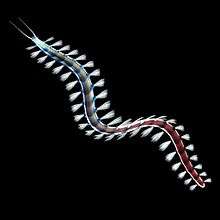Burgessochaeta
Burgessochaeta is an extinct genus of polychaete annelids from the Middle Cambrian. Its fossils have been found in the Burgess Shale in British Columbia, Canada. A total of 189 specimens of Burgessochaeta are known from the Greater Phyllopod bed, where they comprise 0.36% of the community.[1] Specimens have also been found at Marble Canyon.[2] The genus was described by Conway Morris (1979)[3] and re-examined by Eibye-Jacobsen (2004).[4]
| Burgessochaeta | |
|---|---|
 | |
| Reconstruction of Burgessochaeta setigera | |
| Scientific classification | |
| Kingdom: | Animalia |
| Phylum: | Annelida |
| Class: | Polychaeta |
| Family: | †Burgessochaetidae Conway Morris, 1979 |
| Genus: | †Burgessochaeta Conway Morris, 1979 |
| Species: | †B. setigera |
| Binomial name | |
| †Burgessochaeta setigera (Walcott, 1911) | |
| Synonyms | |
|
Canadia setigera Walcott, 1911 | |
Physical characteristics
Burgessochaeta had two long tentacles on its head. The rest of the body had between 16 and 30 segments (possibly indicating multiple species). Each segment had two groups of long chaetae on it, which Burgessochaeta presumably used to swim. Burgessochaeta is not thought to have had eyes. The body grew slightly wider towards the posterior end of the animal.[5]
Ecology
Burgessochaeta is thought to have been a decomposer or scavenger on organic material. It probably swam, as its bristles were much too long to be useful for moving itself in a burrow. Specimens have been found from both continental slope and deep-water environments, indicating that this was a widespread animal.[6]
General sources
- The Crucible of Creation: The Burgess Shale and the Rise of Animals by Simon Conway-Morris
Citations
- Caron, Jean-Bernard; Jackson, Donald A. (October 2006). "Taphonomy of the Greater Phyllopod Bed community, Burgess Shale". PALAIOS. 21 (5): 451–65. doi:10.2110/palo.2003.P05-070R. JSTOR 20173022.
- "Fossilworks: Gateway to the Paleobiology Database". fossilworks.org. Retrieved 2018-02-04.
- Conway Morris, S. (1979). "Middle Cambrian Polychaetes from the Burgess Shale of British Columbia". Philosophical Transactions of the Royal Society of London. Series B, Biological Sciences. 285 (1007): 227–274. Bibcode:1979RSPTB.285..227M. doi:10.1098/rstb.1979.0006. JSTOR 2418139.
- Eibye-Jacobsen, D. (2004). "A reevaluation of Wiwaxia and the polychaetes of the Burgess Shale". Lethaia. 37 (3): 317–335. doi:10.1080/00241160410002027.
- Royal Ontario Museum (2011-06-10). "The Burgess Shale". burgess-shale.rom.on.ca. Retrieved 2018-02-04.
- "Fossilworks: Burgessochaeta". fossilworks.org. Retrieved 2018-02-04.
External links
- "Burgessochaeta setigera". Burgess Shale Fossil Gallery. Virtual Museum of Canada. 2011.
- Burgessochaeta in the Paleobiology Database